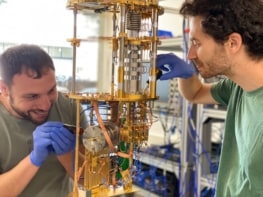
A new way of creating a voltage by shining light on a solid has been developed by researchers in the US and Europe. Unlike most photovoltaic devices, the new system does not rely on semiconductors but rather on surface plasmons in tiny metal nanostructures. The team is now working to create new types of devices that convert light into electrical energy.
Surface plasmons are collective excitations of electrons at the surface of a metal that interact very strongly with light. As a result, plasmons are of great technological interest as an interface between photonics and electronics. This interaction is strongest at the plasmon-resonance frequency, which is defined by the size and shape of an object and its charge density. In 2009 Paul Mulvaney and colleagues at the University of Melbourne in Australia applied an electrical potential to gold nanoparticles, and found that they could tune the plasmon-resonance frequency by injecting or removing electrons.
Sweeping laser
In the new work, applied physicist Harry Atwater and colleagues at California Institute of Technology, together with researchers in the Netherlands, show that the reverse can also occur: a surface potential can be induced by using light to modify the charge density of a nanoparticle. The team made its plasmonic material by attaching gold nanorods with a plasmon-resonance wavelength of 550 nm to an indium-tin-oxide substrate. Then the researchers fired a tuneable laser at the structure, and swept the laser wavelength from 480 nm to 650 nm. During illumination, the electric potential on the surface of the material was monitored using the conductive tip of an atomic force microscope.
When the laser was on resonance with the surface plasmon, no voltage was induced. Irradiation either side of the resonant frequency, however, did produce a voltage. When the wavelength was below 550 nm a negative potential was measured on the gold nanorods, while longer-wavelength light created a positive potential. The team found that the magnitude of the potential related to the rate at which the light absorbance changed with respect to the frequency of the light. The largest potential (which was negative) was produced by illumination at 500 nm. Atwater offers a thermodynamic explanation for this observation: “If you shine light on the structure, free-energy minimization will cause the structure to try to adjust its charge density to bring itself into resonance with the exciting light.” The researchers have dubbed this phenomenon the plasmoelectric effect.
Successful model
The team then used this model to predict the frequency at which the maximum potentials should be generated in its set-up, and found broad agreement with its experimental results. The researchers also checked that the model could be applied generally, by testing it in a different type of plasmonic material: a thin gold sheet studded with a periodic pattern of 10 μm holes mounted on a glass substrate. This too showed a plasmoelectric effect, with the peak negative and positive potentials as predicted by the model.
While the devices reported by the team simply produce a potential difference when illuminated, the team is now working on a device that will deliver usable electrical energy and thereby function as a solar cell. Atwater believes that such a device could complement traditional semiconductor photovoltaic cells: “Any given single-material solar cell can only convert power from photons that have energy greater than the band-gap energy,” he says, “[Our device] could potentially be used behind a conventional photovoltaic cell to harvest the infrared part of the spectrum, because I can design a plasmonic structure to have a resonance at pretty much any frequency.”
Fascinating physics
Nano-optics specialist Thomas Ebbesen of the University of Strasbourg, says: “I find it to be very impressive work. If something like this could become efficient as an energy conversion process that would of course be technologically important. But independent of that, I find the underlying physics very interesting just from a thermodynamic point of view.”
Ortwin Hess of Imperial College London is also impressed, and wants to know more: “Thermodynamics seems to be supporting their experimental and simulation work, and I’m really happy about that,” he says. “Nevertheless, from the microscopic perspective, plasmons are made up of electrons, and in the end I would like to see how that works.” The researchers are working on this question, and Atwater says there will be “a forthcoming theory paper in the near future”.
The research is published in Science.



